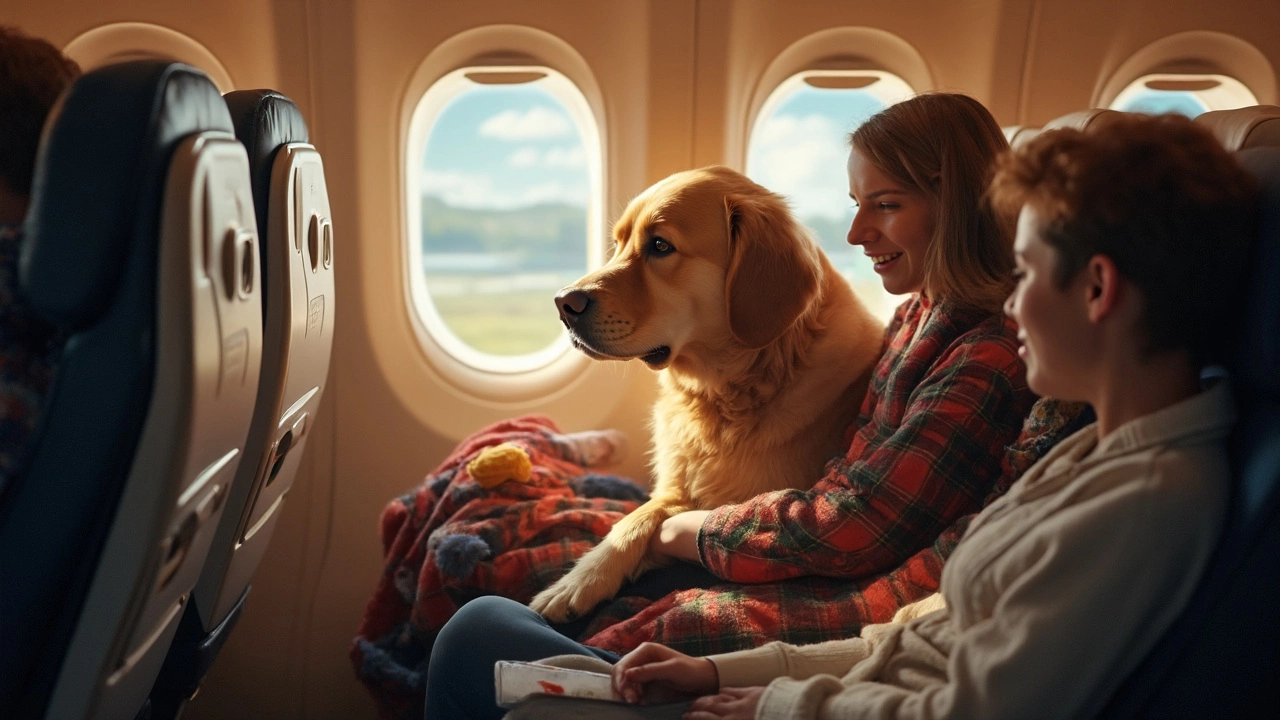So, you're considering taking your furry friend along on your next flight, but here's the million-dollar question: just how big can your dog be to still fly in the cabin with you? Unfortunately, it's not a one-size-fits-all answer, as each airline sets its own rules when it comes to pet travel. But don't worry, we've got some solid info up our sleeves to help guide you.
First thing's first—there's the matter of size and weight limits. For airlines that do allow dogs in the cabin, most have a general rule: the pet, including their carrier, should fit comfortably under the seat in front of you. This usually translates to a combined weight limit ranging from around 15 to 20 pounds, although it can vary from one airline to the next.
- Understanding Airline Policies
- Size and Weight Limits
- Best Practices for Flying with Large Dogs
- Planning Your Trip
Understanding Airline Policies
When you're flying with your pet, knowing airline policies is like having a roadmap for a successful journey. Airlines have specific rules about pet travel, and since these can vary widely, it's crucial to check them out before booking your ticket. Some airlines are more pet-friendly, while others might have stricter guidelines. Let's dive into what you need to know.
Pet-Friendly Airlines
First things first, some airlines have a reputation for being more accommodating to pets. For example, American Airlines and Delta are known for their comprehensive pet travel policies, but they still have weight limits for in-cabin pets. Usually, the total weight, including the carrier, shouldn't exceed about 20 pounds. A strong tip here: always check the airline's website or give them a call to double-check the latest guidelines.
Booking and Reservations
To get a spot for your pet, you might need to make a reservation in advance. Airlines typically have a limit on how many pets can fly in the cabin on each flight. So, once you've got your flight details, contact the airline to secure a place for your pet.
Carrier Specifications
Airlines will also have specifications for the pet carrier. Usually, it needs to be small enough to fit under the seat in front of you, and it should provide enough ventilation for your dog. Materials and dimensions can vary, so make sure your carrier meets those standards.
Fees and Costs
Let's talk about the costs involved. Most airlines will charge a fee for bringing a pet in the cabin. This can range from $95 to $125 one way. It's another good reason to book early, as these spaces can fill up quickly.
| Airline | Max Weight (lbs) | Fee (USD) |
|---|---|---|
| American Airlines | 20 | 125 |
| Delta | 20 | 95 |
| United | 18 | 125 |
Being ready and well-informed can make a huge difference in how smooth your travels will be. With a bit of homework, you'll make sure your buddy gets the VIP treatment they deserve.
Size and Weight Limits
When it comes to flying with your pet, understanding the size and weight limits is key. For most airlines, the main requirement is your dog must fit inside a carrier that can slide under the seat in front of you. This isn’t just about length and width—height plays a big role too. Airlines often have a maximum height for carriers that averages around 9 inches.
Typical Weight Restrictions
Weight limits for dogs flying in cabins generally hit around 20 pounds, carrier included. So, if your pup weighs 15 pounds, you’ve got about 5 pounds left for the carrier. Kind of like putting together a puzzle, isn't it? Unfortunately, if Fido's a big boy, you might be looking at other options like checked pet travel.
Airline-Specific Guidelines
- American Airlines: Allows pets up to 20 pounds with carrier. Carrier dimensions must not exceed 19 x 13 x 9 inches.
- Delta Airlines: Maximum combined weight of 18 pounds, and carrier dimensions capped at 18 x 11 x 11 inches.
- Southwest Airlines: Slightly less strict, allowing a total of 22 pounds but keep the carrier under 17 x 10 x 9.5 inches.
Making sure your carrier meets these guidelines is crucial to avoid last-minute hiccups at the airport. Remember, no one wants to repack their luggage in the middle of a bustling terminal!
Carrier Compliance
Choosing the right carrier means making sure it’s not just the right size, but also comfy for your large dog. Look for ones with plenty of ventilation, a sturdy structure, and maybe even a nice cozy lining. It's going to be your dog's space for several hours, after all.

Best Practices for Flying with Large Dogs
Traveling with a larger canine buddy in the cabin isn't impossible, but it definitely requires some planning and patience. Here's how you can make it happen smoothly.
Get to Know Airline Policies
Start by researching different airlines to find out which ones allow larger dogs in the cabin. Many airlines post their pet policies online, including details on size limits, fees, and carrier requirements. Don't be shy about calling customer service for specifics if you're unsure about anything.
Choose the Right Carrier
The carrier is something airlines take seriously. It should be well-ventilated and just the right size to hold your dog comfortably. Most importantly, it must fit under the seat, unless you're on an airline that provides other accommodations. Look for carriers that have soft sides to allow a bit more flexibility in tight spaces.
Mind the Weight
The combined weight of your dog and their carrier should meet the airline's criteria. If your pooch is on the heavier side, consider going on a few practice runs with the carrier to ensure everything fits and is manageable.
Train Your Dog for Travel
Let's be real—flying can be a stressful experience for both you and your pup. Try to familiarize your dog with their carrier ahead of time and practice getting them comfortable with being inside for extended periods.
Booking and Check-In Tips
- When booking your ticket, it's best to call the airline to make pet reservations if possible.
- Arrive early at the airport to give yourself plenty of time to navigate any potential bumps in the road with pet check-in.
Healthcare Precautions
Always have your dog's health records, including vaccinations, with you. Some airlines and countries require this, so it's better to be prepared than sorry.
Bring Essentials
Keep food, water, and a familiar blanket or toy handy to reduce stress for your big buddy during the flight.
Manipulating the logistics of flying with large dogs can be a balancing act, but with the right preparation, it’s absolutely doable. Keep these practices in mind, and you'll both be on your way to a calm, enjoyable journey in no time!
Planning Your Trip
Ready to jet-set with your furry pal? Planning ahead is the name of the game, and doing your due diligence can make the whole process smoother. Let’s break it down step by step.
Check Airline Regulations
Not every airline has the same rules when it comes to flying with pets. Double-checking airline policies for large dogs ensures you won't be caught off guard at the airport. Always verify pet travel guidelines directly with the airline and book a ticket as early as possible, since only a limited number of pets are allowed in the cabin per flight.
Prepare Your Pet's Carrier
Your buddy needs to be comfortable, so picking the right carrier is crucial. Ensure it meets the airline's size requirements and has good ventilation. It's wise to do a few trial runs at home, allowing your dog to get comfy inside the carrier. Measure and weigh it with your pet inside to ensure it adheres to the airline restrictions.
Health Check and Documentation
Make sure your dog is healthy and fit to fly. A vet check-up before traveling is a must. Many airlines require health certificates issued within a certain timeframe before travel. To avoid last-minute scrambling, prepare these materials early.
Pack Essentials
Don't forget essentials like a collapsible water bowl, leash, and waste bags. A small bag of your dog's favorite treats can be a lifesaver for calming nerves. Keep all the paperwork handy for easy access.
Practical Tips for a Smooth Experience
- Book early morning flights to avoid stress. These flights are generally less crowded and the temps are cooler—more pleasant for your pet.
- Give a light meal a few hours before the flight. It minimizes the chance of motion sickness.
- Consider a calming product if your dog tends to get anxious. Always vet-approved, of course.
Following these steps can make flying with your four-legged friend a less stressful experience. A bit of planning goes a long way!







